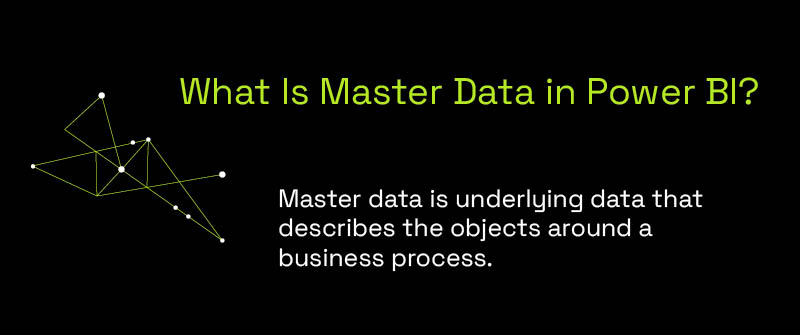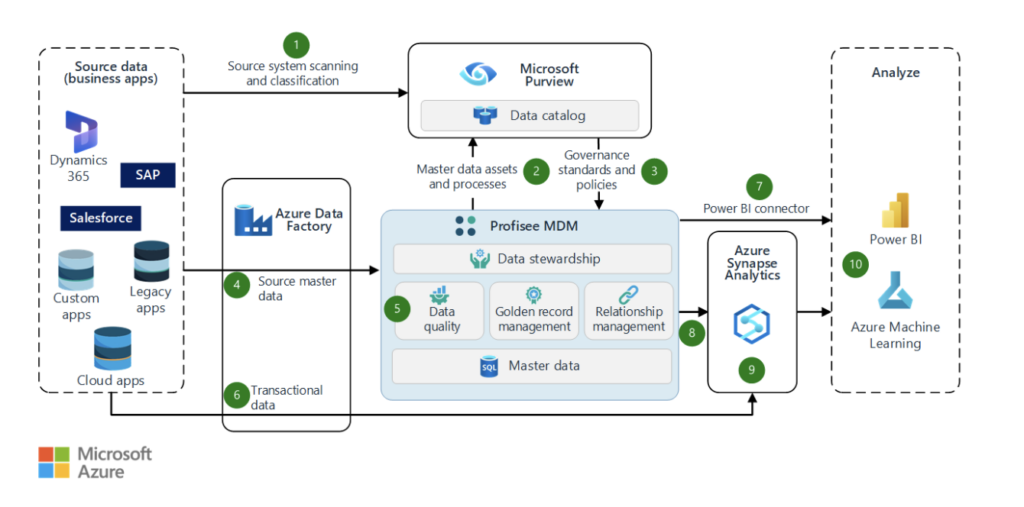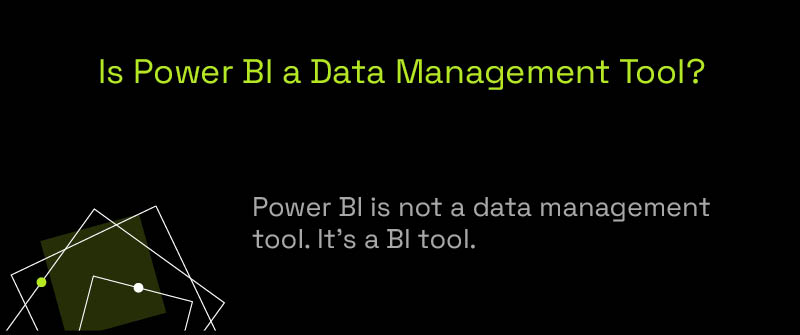
As a Power BI consulting company, we understand that it’s crucial for your analytics process to use accurate data. Reports and dashboards that show the “truth” are what really help in data-driven decision-making.
Master Data Management (MDM) is a solution that helps organizations maintain their critical data. In this article, we’ll help you understand its role, its differences with business intelligence, and its overall impact on your data strategy.
Let’s start with the concepts of Power BI and master data management.
What Is Master Data in Power BI?
Master data is underlying data that describes the objects around a business process. Unlike transactional data, which frequently changes, master data remains relatively static. Examples of master data include customer data, and data about products, suppliers, and locations.
When you manage your master data effectively, it becomes a single source of truth, providing everyone in the organization with the same accurate and up-to-date information. This reduces errors, improves efficiency, and can lead to better decision-making.
Your organization may have standards around master data. These data quality rules can guide data analysts about what types of data transformations they need to apply. Power BI, with its Power Query feature, allows data analysts to save these transformation steps. So, whenever new data comes into reports, it will automatically conform to the standards. Speaking of data analytics; check out Google analytics Power BI.

Master Data and MDM
Now, let’s discuss how MDM can help manage your master data.
Organizations often realize the need for Master Data Management (MDM) when their data becomes unmanageable or inconsistent across various systems. This could be due to rapid growth, structural changes, or events like mergers and acquisitions that introduce new data sources that need reconciliation.
MDM includes a set of processes used to create and maintain an organization’s master data. The master data is standardized, matched, merged, enriched, and validated according to governance rules. An MDM tool is used to enforce these processes. It helps organizations ensure their master data remains accurate and reliable.
Power BI and Master Data Management
With Power BI, you can access the curated master data in an MDM solution and visualize this single source of truth data in reports and dashboards.
Following is an example architecture of an MDM solution:

The diagram above illustrates the role of Power BI as a data visualization tool. It connects to master data with a dedicated connector that recognizes and enforces role-based security.
Furthermore, you can access Azure Synapse and Microsoft Purview’s data catalog in Power BI to create customized reports with slices and dice.
Benefits of Master Data Management (MDM) in Power BI
Master Data Management (MDM) integration with Power BI offers a myriad of benefits for organizations aiming to elevate their analytics capabilities. By implementing MDM alongside Power BI, businesses can unlock numerous advantages that enhance data quality, streamline processes, and drive more informed decision-making.
Improved Data Quality and Consistency: MDM ensures that the master data used in Power BI dashboards and reports remains accurate, consistent, and up-to-date across the organization. By establishing a single source of truth for key data entities such as customers, products, and locations, MDM minimizes errors and discrepancies, thereby enhancing data reliability and trustworthiness.
Streamlined Data Governance: Integrating MDM with Power BI enables organizations to enforce robust data governance policies and standards effectively. Through centralized data management processes, organizations can establish clear rules for data governance, stewardship, and quality control, ensuring compliance with regulatory requirements and internal guidelines.
Enhanced Analytics Performance: By leveraging curated master data within Power BI, organizations can optimize analytics performance and efficiency. MDM eliminates the need for manual data reconciliation and cleansing, enabling data analysts to focus on deriving insights and creating value-added visualizations without being hindered by data inconsistencies or inaccuracies.
Facilitated Decision-Making: MDM integration empowers stakeholders across the organization to make more informed decisions based on trusted, high-quality data. With access to accurate and consistent master data through Power BI, decision-makers can confidently rely on analytics outputs to drive strategic initiatives, identify opportunities, and mitigate risks.
Is Power BI an MDM Tool?
The short answer is no.
Power BI is not an MDM tool. Even though it can often be mistaken as such due to its robust data-handling capabilities, its primary function lies in its ability to serve as a business intelligence (BI) tool and create a data model or visualization.
What Is the Difference Between MDM and BI?
Let’s simplify their differences for a clear understanding.
Master Data Management (MDM)
MDM is a strategic approach employed to maintain data consistency across various systems. It helps establish a unique, consistent definition of data entities and ensures this standardization across multiple systems. MDM involves processes such as data integration, governance, stewardship, and quality assessments.
MDM tool examples: Profisee, Ataccama ONE, IBM InfoSphere MDM, and Informatica MDM.
Business Intelligence (BI)
On the other hand, BI is a technology-driven process designed for data analysis and presentation of actionable information. It helps businesses make informed decisions. BI tools handle data collection from multiple systems, prepare it for analysis, and generate reports and dashboards to effectively visualize insights.
BI tool examples: Power BI, Tableau, and Looker Studio (formerly Google Data Studio). Read more about Tableau vs Power BI.
Is Power BI a Data Management Tool?
Power BI is not a data management tool. It’s a BI tool.
When asking whether Power BI is a data management tool, it’s important to understand what we mean by ‘data management.’ Data management typically involves the development and execution of architectures, policies, practices, and procedures to manage the full data lifecycle within an organization. This can include data creation, storage, maintenance, archiving, and deletion.
Despite its robust capabilities, Power BI is not classified as a data management tool. While it can connect to various data sources and help transform and model data for analysis, it does not perform core data management functions like ensuring data quality, maintaining data governance, enforcing data security, or managing data storage and archiving.
Power BI is fundamentally a BI tool. It converts raw data into meaningful insights through interactive visualizations, dashboards, and reports. It allows everyone in an organization to make informed decisions based on real-time data.

Is MDM Necessary for Your Organization? Start Your Custom Strategic Planning With P3 Adaptive and Improve Your Data Quality Today!
MDM is often perceived as a “heavy” infrastructure project with potential benefits. However, it’s not always the golden ticket. Instead of pouring resources into building an extensive infrastructure first, it’s essential to take a step back and carefully assess your organization’s specific needs and data assets. Our role at P3 Adaptive is to help you navigate this process, ensuring we find the optimal balance that enhances your operations.
When it comes to shaping your data strategy, our approach is holistic. We delve into modern data platform design, adoption and governance strategies, connected analytics, and executive advisory services. Our team is ready to help you set up a robust data governance committee, manage intricate data architecture designs, construct metrics that trigger action, and guide your Power BI implementation.
Ready to revolutionize your data strategy? Let P3 Adaptive be your partner in this journey. Reach out to us today, and together, let’s solve your data problems together.
Get in touch with a P3 team member